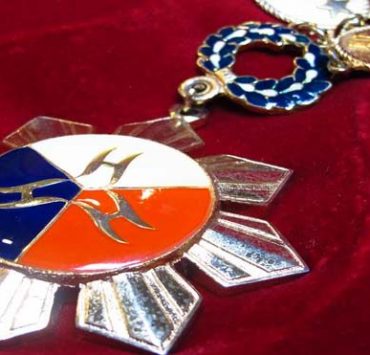Last April, the House Committee on Basic Education and Culture approved a proposal to make Baybayin the country’s national writing system. This means that, once the proposal is enacted, Baybayin translations will be required for: street signs; names of public facilities like buildings, hospitals, fire and police stations, government halls, etc.; food product labels; and print mastheads. The responses to this were mixed. Many approved, but many still remained cautious. Because of this, it’s only appropriate to take a step back and examine Baybayin.
Baybayin is a script developed by the early Tagalogs. To paraphrase Ma. Victoria Gugol’s “Ortography (Evolution)” from the NCCA website, the Baybayin script is syllabic and composed of three vowels and fourteen consonants. The vowels represented are a, i (or e), and u (or o). Being syllabic, each consonant is pronounced with the vowel a, unless a sign called the kudlit is placed over it. The kudlit, which is either a cross or a dot, signifies the use of another vowel: If the sign is written over the letter, the consonant is pronounced with an e or i, and if it is under the letter, the consonant is pronounced with an o or u.
Unlike other alphabets, which are named after their first three letters, Baybayin is named after its convention of letters falling into succession. “Ang Baybayin…ay nangangahulugan ng ‘pagkakasunod-sunod ng mga bagay sa isang hanay’ (sucesion de cosas como en fi la),” Virgilio Almario writes in his introduction to Spanish clergyman Pedro Andres de Castro’s Baybayin: Ortograpiya at mga Tuntinin sa Pagsulat sa Wikang Tagalog.
The early Tagalogs wrote on bamboos, tree barks, and leaves—all “perishable materials, hence no extant specimens exist today,” says Rosa M. Vallejo in “Books and Bookmaking in the Philippines,” on the NCCA website.
When the Spanish colonizers first came to the Philippines, there was an attempt by the friar scholars to learn the language (hence Pedro Andres de Castro’s book), but that attempt was quickly superseded by them ultimately replacing the script with their own alphabet. “It is believed that replacement of the Baybayin by the Roman alphabet must have obliterated a significant aspect of indigenous Philippine literature,” says Dr. Lilia Quindoza-Santiago of the University of the Philippines Diliman in her article “Early Philippine Literature” on the NCCA website.
This brings us to look at what Baybayin can do in terms of decolonizing our language.
Of course, turning Baybayin into our writing system has deep implications for the Filipino identity. “Language is the house of being,” philosopher Martin Heidegger once said, meaning that the way we experience the world is through the language we use.
Quoting Virgilio Almario: “Higit na lalaya at lulusog ang ating pananaw sa ating sarili kapag ibinukas natin ang ating sarili sa iba’t ibang perspektiba ng oryentasyong pangkultura at kapag higit nating pinagbuhusan ng tiyaga ang pagtitig sa natitira’t pira-pirasong gunita ng ating katutubo’t sinaunang sarili. Ang Baybayin ang isang dakilang halimbawa sa nakapagsasariling katangian ng wika at kulturang Filipino.”

Some of the loudest critiques of the bill are that it’ll just be an aesthetic change; it should be taught in schools first before it’s used as a nationwide writing system; and what we need is to better educate children about the Filipino language more. Another is that it’s too late for us to have our own national writing system.
I’ll start with the former: I think more time needs to be spent developing the writing system. I agree that Baybayin is still limited, and it should be taught in schools first. Educators should also have more time to learn up on it so they’ll be able to properly teach their students. However, if those changes are made, it could work well for the next generation. They’ll be learning the language alongside the script, and that’ll enrich their experience of the Filipino language.
Here’s what I can offer on the latter:
Even though it seems like our language and culture have moved on from Baybayin, it’s not too late to bring it back. After all, we’re still a relatively young country. The Koreans created Hangul in 1440 after centuries of using a modified classical Chinese script. Turkey adopted a Latin-style alphabet in 1927 after a thousand years of using a Perso-Arabic script. If the colonizers were able to impress upon us a foreign writing system, we can also do the opposite.
I was careful to note that Baybayin was used by the Tagalogs because, contrary to what a lot of people might have been led to believe, it is not the only writing system developed by the Filipino people. There are, in fact, 16. Kapampangans, for example, have Kulitan, the Bisayas have Badlit, and the Mangyans have Hanunó’o.
You can’t make a case that these scripts are more primitive than Baybayin. Whereas Baybayin was mostly used to codify merchant transactions, the Mangyans use Hanunó’o to write poetry.
This takes us back to the age-old debate about the Filipino language. As a Mindanaoan Bisaya, I’ve heard pretty much all that there has to be said about this. “Filipino is pretty much just Tagalog.” “Filipino is an example of Manila imperialism.” “Filipino doesn’t account for all the many, many languages in the Philippines.”
But one of the more enduring claims I’ve heard once I moved to Metro Manila is that while Filipino is flawed and Tagalog-centric, it’s serviceable and there’s enough intersection with Tagalog and the other Filipino languages anyway that people can understand it. And sure, that’s an easy thing to say—if you’re Tagalog. However, if you’ve lived with a “regional language,” then you know that there’s still a certain sense of disconnect. Filipino is home, but not as much as “uli na ka” (“go home” in Bisaya) is. And you might have also experienced feeling like your mother tongue is informal, maybe even inferior to the actual Filipino language, and has no place in school.
I’ll put it in another way: Is it worth it to decolonize our writing system with a dominant, if still native, force?
Honestly? I’m not so sure.
This story originally appeared in Southern Living Discourse Issue
Get more stories like this by subscribing to our newsletter here.
Read more:
Baybayin could soon be our national writing system
These local tabletop games revisit popular culture, myths, and Baybayin
A 1991 encyclopedia on aswang, engkanto and more just got a reprint
Read more by Zofiya Acosta:
Who’s afraid of the contractual workers?
Women should be able to use contraceptives without fear of abuse
Universities should do more to protect their students
Writer: ZOFIYA ACOSTA
ART TRICIA GUEVARA




